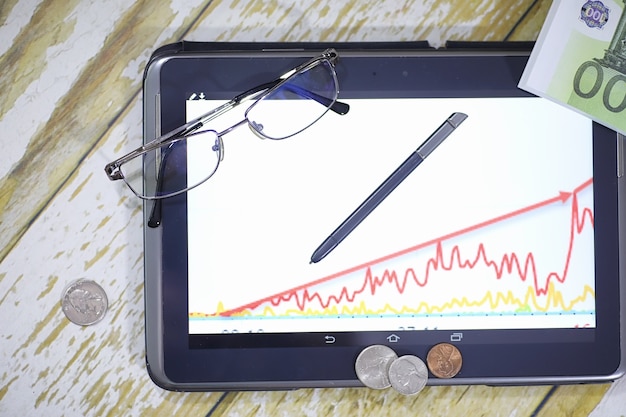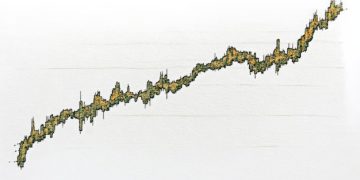ETFs: The Low-Cost Way to Diversify Your Investment Portfolio

Investing in ETFs (Exchange Traded Funds) is a strategic way to diversify your investment portfolio with low-cost funds, offering exposure to a broad range of assets and sectors without the need to individually select stocks or bonds.
Are you seeking a smart and simple way to diversify your investments? Investing in ETFs, or Exchange Traded Funds, might be the answer. These funds offer a basket of investments, allowing you to spread your risk and potentially enhance your returns, all while keeping costs low, which makes them so popular among new and seasoned investors alike.
Understanding ETFs: What Are They?
Exchange Traded Funds (ETFs) have revolutionized the world of investing, providing an accessible and efficient way to diversify your portfolio. But what exactly are they, and how do they work?
Defining Exchange Traded Funds
An ETF is a type of investment fund that holds a collection of assets, such as stocks, bonds, or commodities. It trades on stock exchanges, much like individual stocks, allowing investors to buy and sell shares throughout the day.
Key Characteristics of ETFs
ETFs are known for their diversification, as each fund typically contains a basket of different investments. They also offer transparency, with holdings usually disclosed daily. One of their most attractive features is often a low expense ratio, particularly when compared to actively managed mutual funds.

Investing in ETFs can be a strategic move. What benefits can you experience? Here are some ideas:
- Diversification: ETFs immediately diversify your portfolio, reducing the risk associated with investing in individual stocks or bonds.
- Low Cost: Many ETFs have lower expense ratios compared to actively managed funds, saving you money over the long term.
- Liquidity: Because they trade on exchanges, ETFs can be bought and sold easily throughout the trading day.
- Transparency: ETF holdings are typically disclosed daily, providing investors with clear insight into what they own.
In summary, ETFs offer an efficient and cost-effective way to diversify your investment portfolio. Their unique characteristics make them a popular choice for both beginner and experienced investors looking to achieve their financial goals.
Benefits of Investing in ETFs
Investing in Exchange Traded Funds (ETFs) offers a multitude of benefits that can significantly enhance your investment strategy. Let’s explore some of the primary advantages.
Diversification Advantages
Diversification is one of the most compelling reasons to invest in ETFs. Instead of putting all your eggs in one basket with individual stocks, ETFs allow you to spread your investments across a wide range of assets, reducing the impact of any single investment performing poorly. This can significantly lower your portfolio’s overall risk.
Cost-Effectiveness of ETFs
ETFs are generally known for their low expense ratios compared to actively managed mutual funds. Actively managed funds have higher costs due to the salaries of fund managers and the expenses associated with frequent trading. ETFs, especially those that track a specific index, operate with lower overhead, passing the savings on to investors.
- Low Expense Ratios: ETFs typically have lower management fees, reducing your overall investment costs.
- No Load Fees: Unlike some mutual funds, most ETFs do not charge load fees, which are sales charges or commissions.
- Tax Efficiency: ETFs can be more tax-efficient than mutual funds due to their structure, which reduces capital gains distributions.
Accessibility and Liquidity
ETFs are highly accessible to investors of all levels. They trade on major stock exchanges, making it easy for anyone with a brokerage account to buy or sell shares. Their liquidity ensures that you can quickly convert your investments into cash when needed.

Investing in ETFs provide greater flexibility than other investment options. Here are some points to consider:
- Ease of Trading: ETFs trade like stocks, making them easy to buy and sell throughout the day.
- Real-Time Pricing: You can see the current price of an ETF at any time during market hours, allowing for informed investment decisions.
- Variety of Options: There are ETFs that cover almost every sector, asset class, and investment strategy, providing numerous choices to align with your goals.
In conclusion, the benefits of investing in ETFs, including diversification, cost-effectiveness, accessibility, and liquidity, make them an attractive option for building a well-rounded investment portfolio. By understanding these advantages, you can make informed decisions and optimize your investment strategy.
Different Types of ETFs
Exchange Traded Funds (ETFs) come in various types, each designed to meet specific investment objectives. Understanding the different categories can help you choose the right ETFs for your portfolio.
Broad Market ETFs
Broad market ETFs are designed to track the overall performance of a specific market index, such as the S&P 500 or the NASDAQ Composite. These ETFs provide instant diversification across a wide range of companies within that market. They are a popular choice for investors looking to match the market’s returns without the effort of selecting individual stocks.
Sector ETFs
Sector ETFs focus on specific segments of the economy, such as technology, healthcare, energy, or finance. By investing in sector ETFs, you can target areas of the market that you believe will outperform. However, this approach also comes with higher risk, as sector-specific factors can significantly impact the performance of these ETFs.
The versatility of ETFs can really help boost your investment strategy. A few more options include:
- Industry ETFs: Similar to sector ETFs, industry ETFs concentrate on even narrower segments, such as semiconductors, biotechnology, or renewable energy.
- Bond ETFs: Bond ETFs invest in various types of fixed-income securities, including government bonds, corporate bonds, and municipal bonds.
- Commodity ETFs: Commodity ETFs provide exposure to raw materials like gold, silver, oil, or agricultural products.
International ETFs
International ETFs allow you to invest in foreign markets, providing diversification beyond your home country. These ETFs can focus on specific countries, regions, or emerging markets, offering a way to participate in global economic growth.
When weighing your options, consider this breakdown:
- Country ETFs: Invest in the stock market of a single country, such as Japan, Germany, or Brazil.
- Regional ETFs: Cover a group of countries within a specific geographic area, such as Europe, Asia, or Latin America.
- Emerging Market ETFs: Focus on developing economies, which may offer higher growth potential but also come with increased risk.
In summary, the wide variety of ETF types allows you to tailor your investment portfolio to meet your specific goals and risk tolerance. Whether you prefer broad market exposure, targeted sector investments, or diversification in international markets, there’s likely an ETF to match your needs.
How to Choose the Right ETFs
Selecting the right Exchange Traded Funds (ETFs) for your portfolio involves careful consideration of several factors. Making informed decisions can help you align your investments with your financial goals and risk tolerance.
Assessing Your Investment Goals
Before diving into ETF selection, take the time to clearly define your investment objectives. Are you saving for retirement, a down payment on a house, or another long-term goal? Understanding your goals will help you determine the appropriate investment timeline and risk level.
Evaluating Risk Tolerance
Your risk tolerance refers to the amount of volatility you’re comfortable with in your investments. If you’re risk-averse, you may prefer ETFs that invest in more conservative assets, such as bonds or dividend-paying stocks. If you have a higher risk tolerance, you might consider ETFs focused on growth stocks or emerging markets, which have the potential for greater returns, but also come with higher volatility.
Some tips to keep in mind include:
- Diversification: Choose ETFs that provide broad diversification across different asset classes, sectors, or geographic regions, to reduce overall portfolio risk.
- Expense Ratios: Pay attention to the expense ratios of ETFs, as these fees can impact your returns over time. Opt for ETFs with lower expense ratios whenever possible.
- Liquidity and Trading Volume: Ensure that the ETFs you select have sufficient liquidity and trading volume, so you can easily buy and sell shares without significantly impacting the price.
Analyzing ETF Performance
While past performance is not indicative of future results, it can provide valuable insights into an ETF’s historical returns and risk profile. Review the ETF’s track record over different time periods, such as 1 year, 3 years, 5 years, and 10 years, to assess its performance in various market conditions.
Be aware that there are other aspects of ETFs that have significant impact in your portfolio:
- Index Tracking: If the ETF tracks a specific index, evaluate how closely it has followed the index’s performance over time. A well-managed ETF should have minimal tracking error.
- Fund Manager: Research the fund manager responsible for managing the ETF. A reputable and experienced fund manager can contribute to the ETF’s success.
- Tax Efficiency: Consider the tax implications of investing in ETFs. Some ETFs are more tax-efficient than others, which can impact your after-tax returns.
In summary, choosing the right ETFs requires a thorough assessment of your investment goals, risk tolerance, and the ETFs themselves. By carefully evaluating these factors, you can build a well-diversified portfolio that aligns with your financial objectives.
Strategies for Investing in ETFs
Once you’ve chosen the right Exchange Traded Funds (ETFs) for your portfolio, it’s essential to develop effective strategies to maximize your returns and manage risk. Let’s explore some popular approaches to investing in ETFs.
Dollar-Cost Averaging
Dollar-cost averaging involves investing a fixed amount of money at regular intervals, regardless of the ETF’s price. This strategy helps to smooth out the impact of market volatility, as you’ll be buying more shares when prices are low and fewer shares when prices are high. Dollar-cost averaging can be a particularly effective strategy for long-term investors who want to gradually build their ETF holdings over time.
Buy-and-Hold Strategy
The buy-and-hold strategy entails purchasing ETFs and holding them for an extended period, regardless of short-term market fluctuations. This approach is based on the belief that, over the long term, the market will generally trend upward. By avoiding frequent trading, you can minimize transaction costs and potential capital gains taxes.
Diversifying your ETFs can be one way to boost your portfolio returns. Here are a few suggestions:
- Diversification: Allocate your investments across different asset classes, sectors, and geographic regions to reduce overall portfolio risk.
- Rebalancing: Periodically rebalance your portfolio to maintain your desired asset allocation. Sell some of the assets that have performed well and buy more of the assets that have lagged behind.
- Long-Term Perspective: Stay focused on your long-term investment goals and avoid making emotional decisions based on short-term market fluctuations.
Tactical Allocation
Tactical allocation involves making adjustments to your ETF holdings based on short-term market conditions. This approach requires more active management and a greater understanding of market dynamics. Tactical allocation may involve overweighting certain sectors or asset classes that are expected to outperform, while underweighting those that are expected to underperform.
Here are some other ways of thinking about tactical allocation:
- Market Timing: Attempt to time the market by buying ETFs when prices are low and selling ETFs when prices are high. Market timing is notoriously difficult and can often lead to missed opportunities.
- Trend Following: Identify and follow market trends by buying ETFs that are trending upward and selling ETFs that are trending downward. Trend following can be a profitable strategy, but it also comes with the risk of false signals and whipsaws.
- Risk Management: Use stop-loss orders to limit your potential losses on ETF investments. A stop-loss order automatically sells an ETF when its price falls below a certain level.
In conclusion, there are various strategies you can implement when investing in ETFs, each with its own advantages and risks. Whether you prefer a passive approach like dollar-cost averaging or a more active approach like tactical allocation, it’s essential to choose strategies that align with your investment goals, risk tolerance, and time horizon.
Potential Risks and How to Mitigate Them
Investing in Exchange Traded Funds (ETFs) carries certain risks that investors should be aware of. Understanding these risks and implementing strategies to mitigate them can help protect your portfolio and enhance your returns.
Market Risk
Market risk is the possibility that the overall market will decline, causing the value of your ETF investments to decrease. Market risk can be influenced by various factors, such as economic conditions, political events, and investor sentiment.
Tracking Error
Tracking error refers to the difference between the performance of an ETF and the performance of its underlying index. While ETFs are designed to closely track their benchmarks, imperfect replication and fund expenses can lead to tracking error.
Other things to keep in mind include:
- Fund Manager Expertise: Choose ETFs managed by experienced and reputable fund managers who have a track record of minimizing tracking error.
- Expense Ratios: Opt for ETFs with lower expense ratios, as these fees can contribute to tracking error over time.
- Index Replication Method: Understand the method used by the ETF to replicate its index. ETFs that use full replication (holding all the securities in the index) tend to have lower tracking error than those that use sampling (holding a representative sample of the index).
Liquidity Risk
Liquidity risk is the possibility that you may not be able to easily buy or sell ETF shares at a fair price. This risk is more pronounced for ETFs that trade in smaller volumes or invest in illiquid assets.
- Trading Volume: Choose ETFs with high trading volumes, as this indicates greater liquidity and the ability to buy or sell shares without significantly impacting the price.
- Bid-Ask Spreads: Pay attention to the bid-ask spread of an ETF, which is the difference between the highest price a buyer is willing to pay (bid) and the lowest price a seller is willing to accept (ask). Narrower bid-ask spreads indicate greater liquidity.
- Underlying Asset Liquidity: Consider the liquidity of the assets held by the ETF. If the ETF invests in illiquid assets, it may be more difficult to trade during periods of market stress.
In conclusion, while investing in ETFs offers numerous benefits, it’s crucial to recognize and assess the potential risks involved. By understanding market risk, tracking error, and liquidity risk, you can implement strategies to protect your portfolio and achieve your investment goals.
| Key Point | Brief Description |
|---|---|
| 📊 Diversification | ETFs offer diversification across various assets, reducing overall portfolio risk. |
| 💸 Lower Costs | ETFs typically have lower expense ratios compared to mutual funds, saving investment costs. |
| 💧 Liquidity | ETFs trade like stocks, providing high liquidity and ease of buying and selling. |
| 🌱 Growth Strategy | Implement dollar-cost averaging for steady, long-term ETF investment growth. |
Frequently Asked Questions
▼
An ETF, or Exchange Traded Fund, is a type of investment fund that holds a collection of assets like stocks or bonds, and trades on stock exchanges just like individual stocks.
▼
ETFs diversify a portfolio by holding a basket of different investments, spreading risk across various assets. This reduces the impact of a single investment performing poorly.
▼
The main benefits of ETFs include diversification, lower expense ratios compared to actively managed funds, and liquidity, as they can be easily bought and sold on exchanges.
▼
Popular strategies include dollar-cost averaging, where you invest a fixed amount regularly, and a buy-and-hold strategy, where you hold ETFs for an extended period.
▼
Potential risks include market risk, which can cause the value of investments to decrease, and tracking error, which is the difference between the ETF’s performance and its underlying index.
Conclusion
Investing in Exchange Traded Funds (ETFs) presents a compelling opportunity to diversify your investment portfolio, reduce costs, and gain exposure to a wide range of assets. By understanding the various types of ETFs, employing effective investment strategies, and mitigating potential risks, you can leverage ETFs to achieve your financial objectives and build a resilient investment portfolio, so take charge of your investment strategy with ETFs today for a more secure financial future.





